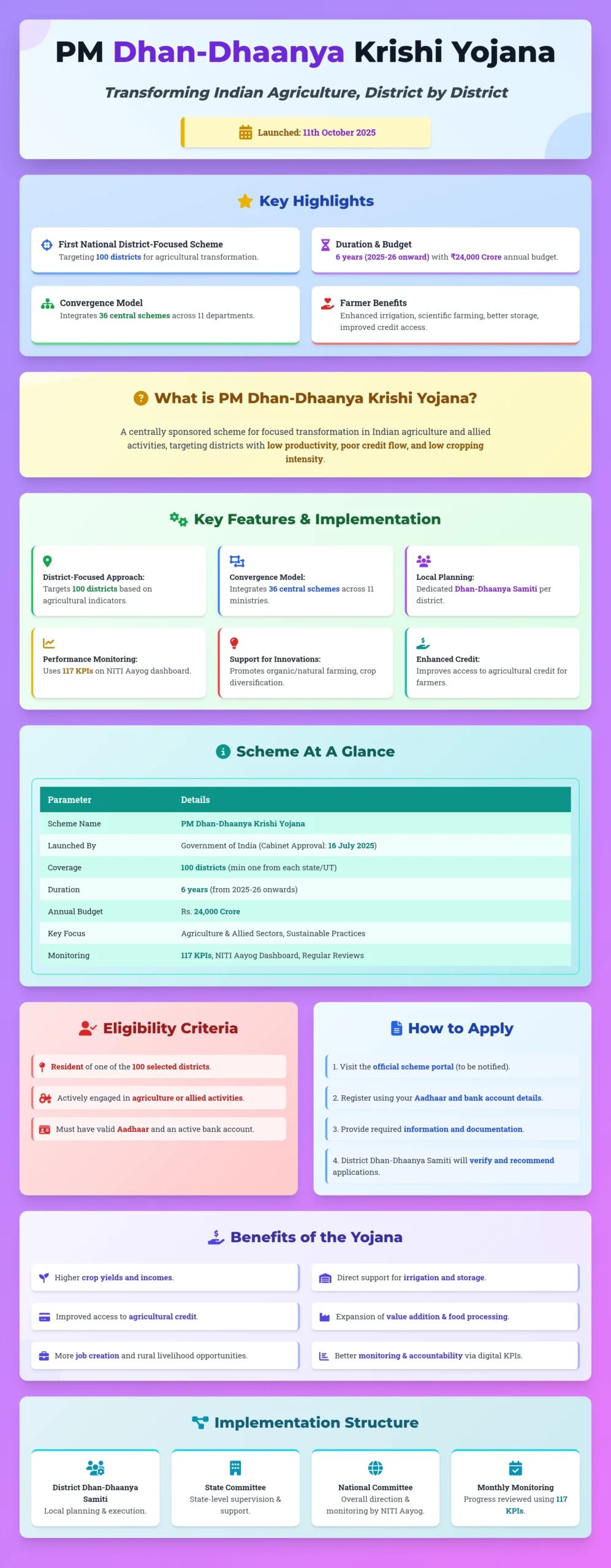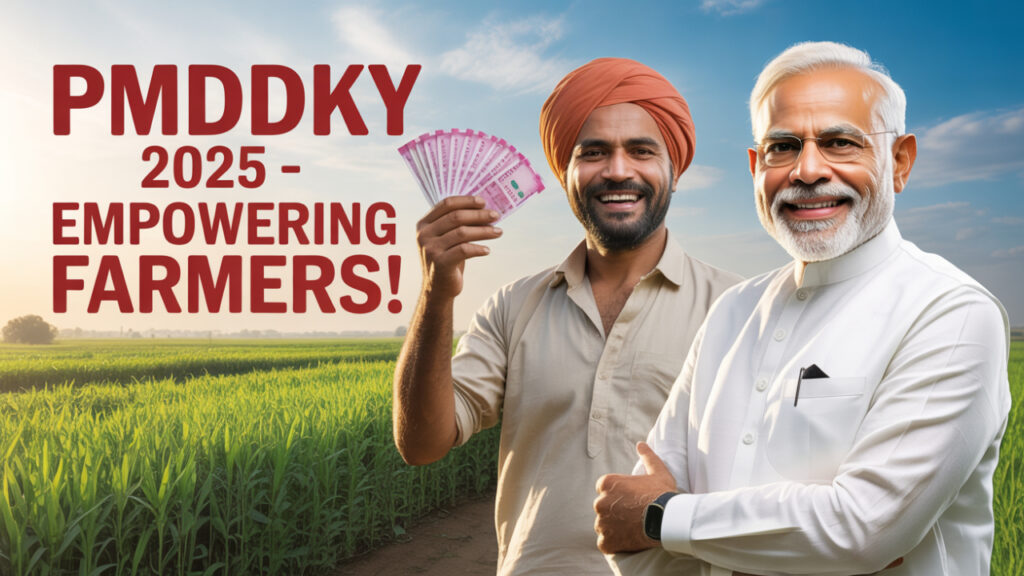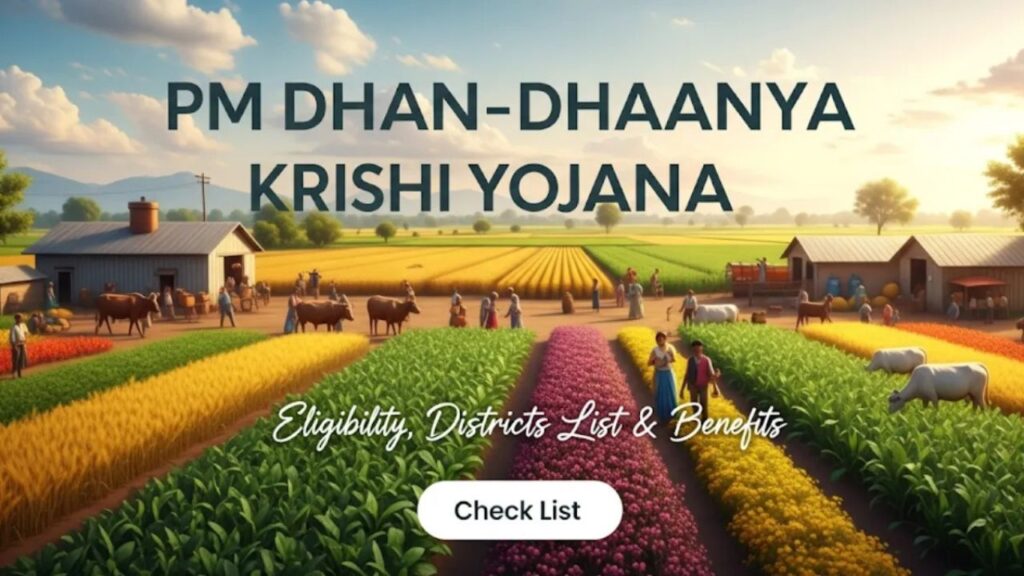India is an agricultural powerhouse, with more than 54% of its population dependent on farming. For this reason, the government is going to implement the PM Dhan Dhaanya Krishi Yojana to increase agricultural productivity and crop diversification in the country. The scheme will be implemented for six years starting from 2025-26 with an annual outlay of Rs. 24,000 crore. It is believed that this scheme will be a game changer for farming.
The Pradhan Mantri Dhan-Dhaanya Krishi Yojana (PMDDKY) is a groundbreaking government initiative launched to revolutionize Indian agriculture by making it more productive. PM Dhan-Dhaanya Krishi Yojana is India’s first national district-focused scheme to transform agriculture and allied sectors.

Through this scheme, farmers will be encouraged to adopt modern farming and their income will be increased. 1.7 crore farmers will benefit from this scheme. Further, the initiative is inspired by the NITI Aayog’s Aspirational Districts Programme.
Contents
Overview – Pradhan Mantri Dhan Dhaanya Krishi Yojana
| Scheme Name | PMDDKY |
| Scheme Full Name | Pradhan Mantri Dhan Dhaanya Krishi Yojana |
| Launched In | 2025 |
| Target Beneficiaries | 1.7 crore farmers across 100 districts |
| District Selection By | NITI Aayog + Ministry of Agriculture |
| Selection Criteria | Productivity, Credit Access, Cropping Intensity |
| Implementation Period | 6 years (2025–2031) |
| Budget Allocated | ₹24,000 crore per year |
What is PM Dhan Dhaanya Krishi Yojana?
PM Dhan-Dhaanya Krishi Yojana is a centrally sponsored scheme designed to transformation Indian agriculture and allied activities. Under this scheme, those districts will be selected where there is low productivity, poor credit flow, and low cropping intensity. The scheme identifies 100 districts across the country for intensive agricultural reform and targeted assistance.

The selection of districts is done scientifically to ensure maximum impact and at least one district from every State and UT is included. Under the PM Dhan Dhanya Krishi Yojana, emphasis will be placed on increasing farmers’ income and agricultural production. Areas with low pulse production will be encouraged to increase production. For this, farmers will also be given benefits under various schemes.
Pradhan Mantri Kaushal Vikas Yojana Courses List
Key Features and Implementation
- Increasing agricultural yields so that farmers can maximize profits from their land.
- Crop diversification means growing a variety of crops instead of relying on a single crop and making farming more environmentally friendly.
- Strengthening the irrigation system so that farmers do not face water problems throughout the year.
- Easy access to agricultural credit, allowing farmers to easily access short- or long-term loans as needed.
- Regular handholding by government agencies and expert farmers.
- Better monitoring and accountability through digital KPIs dashboard.
Farmers of these 100 districts will get benefits
| State/UT | Major Farming Districts | Primary Crops Grown |
|---|---|---|
| Uttar Pradesh | Lakhimpur Kheri, Sitapur, Bijnor, Azamgarh, Barabanki | Wheat, rice, sugarcane, pulses |
| Bihar | Rohtas, Nalanda, Gaya, Madhubani, Purnia | Paddy, maize, pulses, vegetables, makhana |
| Madhya Pradesh | Sehore, Vidisha, Hoshangabad, Chhindwara, Jabalpur | Wheat, soybean, gram, pulses |
| Punjab | Ludhiana, Patiala, Sangrur, Bathinda, Moga | Wheat, rice, maize, cotton |
| Haryana | Karnal, Hisar, Kurukshetra, Sirsa, Fatehabad | Wheat, rice, sugarcane, cotton |
| Rajasthan | Sriganganagar, Kota, Baran, Banswara, Alwar | Bajra, mustard, wheat, gram |
| Chhattisgarh | Bastar, Raipur, Bilaspur, Kanker, Dhamtari | Rice, maize, pulses |
| Odisha | Kalahandi, Koraput, Mayurbhanj, Bargarh, Malkangiri | Paddy, oilseeds, millets, cotton |
| Jharkhand | Ranchi, Gumla, Palamu, Simdega, Hazaribagh | Rice, maize, pulses, vegetables |
| West Bengal | Burdwan, Bankura, Murshidabad, Malda, Nadia | Rice, jute, potato, vegetables |
| Assam | Nagaon, Barpeta, Dhubri, Golaghat, Sivasagar | Paddy, tea, pulses, mustard |
| Andhra Pradesh | Guntur, Krishna, Nellore, Anantapur, East Godavari | Rice, cotton, chillies, groundnut |
| Telangana | Nizamabad, Karimnagar, Khammam, Mahbubnagar, Warangal | Cotton, rice, maize, red gram |
| Tamil Nadu | Thanjavur, Erode, Salem, Villupuram, Coimbatore | Rice, sugarcane, banana, turmeric |
| Karnataka | Mandya, Tumakuru, Belagavi, Mysuru, Raichur | Ragi, jowar, pulses, sugarcane |
| Kerala | Wayanad, Idukki, Palakkad, Kottayam, Thrissur | Coconut, rubber, spices, rice |
| Gujarat | Rajkot, Junagadh, Surendranagar, Sabarkantha, Banaskantha | Cotton, groundnut, millet, castor |
| Maharashtra | Nashik, Ahmednagar, Jalgaon, Nagpur, Solapur | Cotton, sugarcane, onion, soybean |
| Uttarakhand | Udham Singh Nagar, Nainital, Almora, Haridwar | Rice, wheat, pulses, fruits |
| Himachal Pradesh | Kangra, Mandi, Shimla, Solan, Kullu | Apples, maize, rice, vegetables |
| Goa | North Goa, South Goa | Rice, coconut, cashew |
| Tripura | West Tripura, Dhalai, Sepahijala | Rice, pineapple, vegetables |
| Manipur | Imphal West, Imphal East, Thoubal, Churachandpur | Rice, maize, pulses |
| Meghalaya | East Khasi Hills, West Garo Hills | Rice, maize, ginger, turmeric |
| Nagaland | Dimapur, Kohima, Mokokchung | Rice, maize, millets |
| Mizoram | Aizawl, Lunglei | Rice, banana, ginger |
| Sikkim | East Sikkim, South Sikkim | Organic vegetables, cardamom, ginger |
| Arunachal Pradesh | Papum Pare, West Kameng, Lohit | Paddy, maize, millets |
| Delhi (UT) | Outer Delhi, North West Delhi | Vegetables, fruits, flowers (limited but present) |
| Puducherry (UT) | Karaikal | Paddy, sugarcane, groundnut |
| Jammu & Kashmir | Anantnag, Baramulla, Kupwara, Udhampur | Rice, apple, maize, saffron |
| Ladakh (UT) | Leh, Kargil | Barley, wheat, vegetables (limited due to climate) |
| Andaman & Nicobar | South Andaman, North & Middle Andaman | Coconut, areca nut, fruits |
| Lakshadweep (UT) | Kavaratti, Agatti | Coconut, root crops (very limited) |
| Chandigarh (UT) | Limited agriculture (mostly urban) | Urban farming, vegetables in peri-urban areas |
| Dadra & Nagar Haveli and Daman & Diu (UT) | Silvassa, Daman, Diu | Rice, millets, vegetables |
How to Apply for PM Dhan Dhaanya Krishi Yojana
Step 1: Visit the official scheme portal (to be notified soon; current updates may be found on pmkisan.gov.in or through district agriculture offices).
Step 2: Register using your Aadhaar and bank account details.
Step 3: Provide required information and documentation as per guidelines announced for your district.
Step 4: District Dhan-Dhaanya Samiti will verify and recommend applications for benefits under the scheme.
Agricultural productivity is not uniform across the country, and different states produce different crops. Therefore, the government has identified districts with low productivity and will make special efforts to increase productivity in them.

